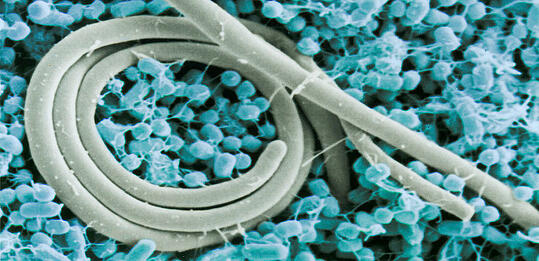Despite our best efforts to eat fully cooked, virus-free food, 42,000 Americans fall victim to Salmonella infections each year. Once it’s inside you, there’s nothing you can do except for wait it out and miserably resolve never to make the same mistake twice. This utter helplessness inspired bioresearchers at Ohio State University to develop a secret weapon against the bacteria that targets a rather surprising weakness.

(Salmonella, depicted here as gray worms. Courtesy Wikimedia Commons and the US Department of Agriculture)
Since Salmonella is just a type of bacteria, it’s tempting to suggest the use of antibiotics to fight it and call it a day. There are two major problems with this approach: first, using antibiotics against any bacteria always brings with it the risk of creating antibiotics-resistant “superbugs.” Generally, one desires to keep antibiotics use at a minimum. Also, Salmonella makes its home in the intestine, where several other sorts of bacteria are doing good work for your body. Killing those bacteria will make digestion tougher, which is the last thing you want when suffering from the side effects of a Salmonella infection.
 Fortunately, Salmonella has a devastating weakness that researchers had never previously considered because of its unlikelihood: in order to survive, it depends almost entirely on a single nutrient. “In the gut, Salmonella can obtain hundreds of different nutrients. But without fructose-asparagine, it’s really unfit,” says Brian Ahmer, associate professor of microbial infection and immunity at Ohio State University. “If you could block Salmonella from getting that nutrient, you’d really stop Salmonella.” The approach Ahmer suggests for fighting the bacteria is simple: block the absorption of this single nutrient.
Fortunately, Salmonella has a devastating weakness that researchers had never previously considered because of its unlikelihood: in order to survive, it depends almost entirely on a single nutrient. “In the gut, Salmonella can obtain hundreds of different nutrients. But without fructose-asparagine, it’s really unfit,” says Brian Ahmer, associate professor of microbial infection and immunity at Ohio State University. “If you could block Salmonella from getting that nutrient, you’d really stop Salmonella.” The approach Ahmer suggests for fighting the bacteria is simple: block the absorption of this single nutrient.
Such a method has never before been considered because bacteria aren’t generally picky. If you stopped them from eating just one type of food, they would hardly even notice. On the other hand, Ahmer found that Salmonella was 100 to 10,000 times less effective at sustaining infection symptoms if they were unable to access fructose-asparagine. “For some reason, Salmonella really wants this nutrient, and if it can’t get this one, it’s in really bad shape,” muses Ahmer, who is as surprised as anyone about the results. His attitude is that these are the lemons he’s given, and so he’s making lemonade in the form of gene-inhibiting drugs.
Ahmer’s fight against Salmonella is supported by grants from the National Institute of Allergy and Infectious Diseases and the National Institute of General Medical Sciences. For more details on the funding for research at Ohio State University, peruse our Ohio State University Funding Report:
If you are an OSU researcher or laboratory supplier, and would like to boost awareness of your products and increase scientific sales, plan to attend Biotechnology Calendar, Inc.'s next Columbus BioResearch Product Faire™. This event is held annually on the Ohio State University campus and will happen next on August 7, 2014. Biotechnology Calendar, Inc. has been bringing life science research trade shows to top research campuses for 20 years now. To reserve space for our Columbus show, please click the button below. If you’d like to attend a show closer to home, please see our 2014 schedule.



